#SS Vaterland
Explore tagged Tumblr posts
Note
I'm building a catamaran-style steampunk crane vessel based on sort of a 1920s ocean liner style. Any recommendations to better understand the internals and layout of the ship?
This ask has been sitting in my inbox for MONTHS and I'm DEEPLY sorry it took this long to respond.
So, the thing about the 1920s in regards to ocean liners is that it was a VERY strange era. Almost everything ocean liner related ceased during World War 1, and none of the existing liners were back in service until around 1920 or 1921. The “newest” liners by this point were 10 years old, and it was the Balan trio: Imperator (now Berengaria), Vaterland (now Leviathan) and Bismarck (now Majestic). They were German liners, and they were handed over to the US and Britain as war reparations. They were renamed and renovated to varying Degrees. Majestic was virtually untouched, and Vaterland was basically a brand new ship after the renovations. The first new “big players” on the Atlantic were the Bremen and the Europa, from 1928. They're much more associated with the 30s, though. So, in regards to stylings, most 1920s ocean liners were extremely reminiscent of the 1910s. And one of the most beloved ships of the 1920s was the RMS Olympic, sister to Titanic. So, in regards to your questions, here is what I think would work best.
First, to get a good idea of the interior decor and layout of a ship from this era, I would recommend downloading the free demo of Titanic: Honor and Glory. Titanic was almost identical to Olympic, and had she not sunk, she would have served through the 20s alongside her. So this will give you a really good perspective on what a passenger would experience on one of these voyages. Getting to walk around and explore these areas in first person will give you a really good perspective on what you're looking for. Furthermore, in terms of construction and design, Olympic and Titanic are very similar to the RMS Baltic, RMS Cedric, RMS Celtic, and RMS Adriatic, which all entered service between 1901 and 1907. So exploring Titanic will give you a really good idea of how most White Star liners were laid out and decorated between 1900 and 1930. All White Star liners were also built by the same company, Harland and Wolf, so it makes sense that they're all so similar. The only thing to remember is that Olympic and Titanic are about twice the size of most other White Star Liners, and much more extravagant. If you want a good idea of how the smaller liners were decorated, I'd recommend just looking up “(ship name) interior” on Google or something. Along with these liners, I'd also recommend looking into the Cunard liners, like Lusitania, Mauretania, Carmania, Caronia, Aquitania, etc. These ships were built by many different ship yards, and the interiors were designed by totally different people, so these ships are much more diverse in terms of styling and Decor. Lusitania and Mauretania, for example, barely resemble each other on the inside. They're sisters, so they have the same rooms and deck plans, but Lusitania Was full of bright white plaster with gold accents, and Mauretania was paneled in lots of dark wood. None of the ships I have mentioned thus far were scrapped until the mid 30s, so they all served between 1920 and 1929.
So here's my list Of the liners most popular between 1920 and 1929, in no particular order:
RMS Olympic (1911)
RMS Mauretania (1907)
RMS Aquitania (1914)
RMS Berengaria/SS Imperator (1913)
SS Leviathan/SS Vaterland (1914)
RMS Majestic/SS Bismarck (1914)
RMS Adriatic (1907)
Now, what I said above is how to do it in a historically accurate way. However, lots of people associate the 1920s with art deco, even though the art deco movement in decor didn't kick off until the 30s. Another good resource for the interior layout of ocean liners of this era is the RMS Queen Mary, currently docked permanently in long Beach California, serving as a floating hotel. She was built in the 30s, but many passengers remarked that her layout was remarkably similar to the RMS Aquitania of 1914, even if the decor was completely different. If you can't go to California, I'd recommend looking up a tour on YouTube. Her art deco interiors are GORGEOUS. The most famous and prominent Art Deco liners were The Queen Mary, Queen Elizabeth, Normandie, and Caronia (not the one from 1905, this one was built in the late 40s and they share a name), and I'd also reccomend looking into the Bremen and Europa. They came a bit before art deco became popular, but they still featured a lot of the decor that would ultimately Popularize art deco.
Thank you SO much for your ask. If you have any more questions or need more detailed advice, PLEASE reach out to me! Send another ask or a DM! I love helping people with this kind of stuff!
#oceanliners#oceanliner#ocean liners#ocean liner#rms olympic#rms mauretania#rms titanic#rms majestic#rms baltic#rms cedric#rms celtic#rms adriatic#rms aquitania#ss imperator#rms berengeria#ss vaterland#ss leviathan#ss bismarck#rms queen mary#rms queen elizabeth#ss Normandie#1920s#1930s#art deco
25 notes
·
View notes
Text

"MIGHTIEST FOR WAR AND FOR PEACE. Uncle Sam's latest and largest battleship U.S.S. COLORADO' docked alongside the giant S.S. "LEVIATHAN."
Both Queens of the Seas. COLORADO, (left) the largest of Uncle Sam's battleships, was dwarfed in the shadow of the giant Leviathan as they lay together for the first time at the River Pier at West 44th St., N.Y. COLORADO looks like a tiny craft alongside of the mighty Levnathan."
Date: November 9, 1923
AP Photo: link
#USS COLORADO (BB-45)#USS COLORADO#Colorado Class#Dreadnought#Battleship#Warship#Ship#SS Leviathan#Leviathan#Imperator Class#SS Vaterland#Vaterland#United States Lines#Passenger Ship#United States Navy#U.S. Navy#US Navy#USN#Navy#New York City#New York#East Coast#November#2023#interwar period#my post
31 notes
·
View notes
Text

uss leviathan, formerly vaterland, being coaled in brest, france during wwi. the photographer stands on the port bridge wing looking aft. postcard ca. 1918
#postcard#postcards#ocean liner#ocean liners#uss leviathan#ss leviathan#ss vaterland#wwi#photography#history#1910s#SUPER COOL CARD❗️❗️❗️
12 notes
·
View notes
Text

Shipcember day 3 - HAPAG Liner
Sooo this day wasn't originally in my to-do list but I've been into messing around with my sketches lately so I decided to doodle designs for berengaria and leviathan in their german era. Im a sucker for black and gold, neuron activation.
#shipcember#ship december#artists on tumblr#small artist#character design#shipposting#ocean liner#ocean liners#hapag#ss vaterland#ss imperator
10 notes
·
View notes
Text
Yet another very important question:
#ocean liners#history#SS Imperator#RMS Berengaria#SS Vaterland#SS Leviathan#SS Bismark#RMS Majestic#Cunard#White Star Line#HAPAG#United States Line
13 notes
·
View notes
Text
Ah, that's the RMS Olympic in a floating dry dock. :3 The dry dock would be pumped full of water and partially submerged, and then a ship is floated over the submerged deck. Then, the water is pumped out, which lifts the ship out of the water. Ocean liners needed to be dry docked pretty regularly to carry out repairs and clean the hull. This photo is sometime between 1923 and 1933. You can tell because the Olympics gold sheer line isn't flush with the white paint of the superstructure, meaning it was after White Star received the RMS Majestic in 1922, and you can also see one of the red white and blue funnels of the SS Leviathan in the background.
Here are some pictures of the RMS Mauretania in dry dock :3



You can see the Olympic and the Empress of Britain in the 3rd one :3
i love having adult horse girl friends. I’ll send them a 100x100px crunchy ass jpeg of a random brown horse and be like “thought of u🐴” and I can literally feel their sims relationship bar fill up in real time
#ocean liners#ocean liner#oceanliner#rms titanic#titanic#cunard#rms olympic#olympic#rms mauretania#rms majestic#ss leviathan#ss vaterland#ss bismarck#rms empress of Britain
119K notes
·
View notes
Note

Ss Vaterland/Leviathan's winter garden space.

"It's nice and cozy...but the plants look a little off"
2 notes
·
View notes
Text
Drought reveals 100-year-old shipwreck in Texas river #Drought #maritime #shipwreck #texasriver #WorldWarOne
0 notes
Text
Sculpsit, his mark
The gray blur’s nominal subject is far in the background, but it doesn’t need to be close to you. It is so big, and in its time it had always been so famous.

George Grantham Bain Collection, Library of Congress, https://www.loc.gov/pictures/item/2014703606/
The largest commercial vessel in the world when it was launched in 1913, the North German Lloyd liner Vaterlandwas at its American pier…
View On WordPress
0 notes
Text

USS LEVIATHAN (ID-1326) arrives with 8,000 U.S. troops, as she pulled into her dock at New York City. She was the largest transport in American service at the time.
Photographed by Kadel & Herbert on February 8, 1919
NARA: 26433439
#USS LEVIATHAN (ID-1326)#USS LEVIATHAN#Imperator Class#Troop Transport#SS Vaterland#Vaterland#SS Leviathan#Leviathan#United States Lines#Passenger Ship#Ship#United States Navy#U.S. Navy#US Navy#USN#Navy#New York City#New York#East Coast#February#1919#interwar period#my post
22 notes
·
View notes
Text
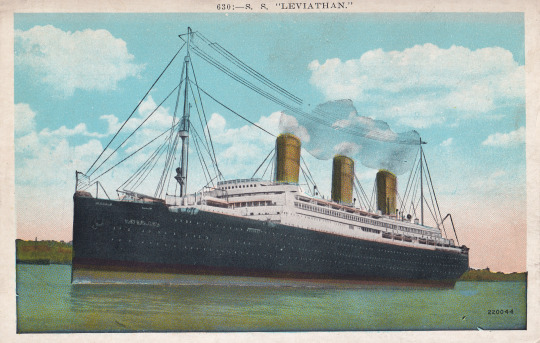
united states lines' ss leviathan postcard ca. early 1920s
while claiming to depict leviathan, in this card you can still read vaterland on the bow, and see that the funnels are not yet US lines' colors. when wwi broke out vaterland laid up in then-neutral US harbor, but was seized upon the country's entry into the war. she was the only german ship in US harbor that wasn't sabotaged by her crew before seizure.
#postcard#postcards#ocean liners#ss leviathan#ss vaterland#united states lines#wwi#1920s#very interesting ship!!#also no doubt best liner name ever. like how fuckin sick is “leviathan” are u kidding
8 notes
·
View notes
Photo

The SS Leviathan from the US Lines leaving port in the 1920s. Until the end of WW1 this ship was a german HAPAG-liner named SS Vaterland. It was finished in 1914 and it held the title of biggest ship in the world until 1922.
32 notes
·
View notes
Text


Social Hall, SS Bismarck, 1914
The Bismarck was to be a HAPAG ship - the world's largest ocean liner in fact. Part of a trio started by the phenomenal Imperator, followed up by the spectacular Vaterland, the war never saw Albert Ballin's ship of dreams come to be. Instead, the most modern of the trio set to feature a more modern, Neo-Classical interior scheme (save for the Social Hall) sat unfinished, then caught fire, and was completed to go on as WSL's RMS Majestic.
I have kind of fudged this, no coving - and honestly I think the tapestries I have fitted would have been there (being in Imperator and Vaterland). It's a work in progress!
Special thanks to @felixandresims @thejim07 @the-regal-sim
5 notes
·
View notes
Photo
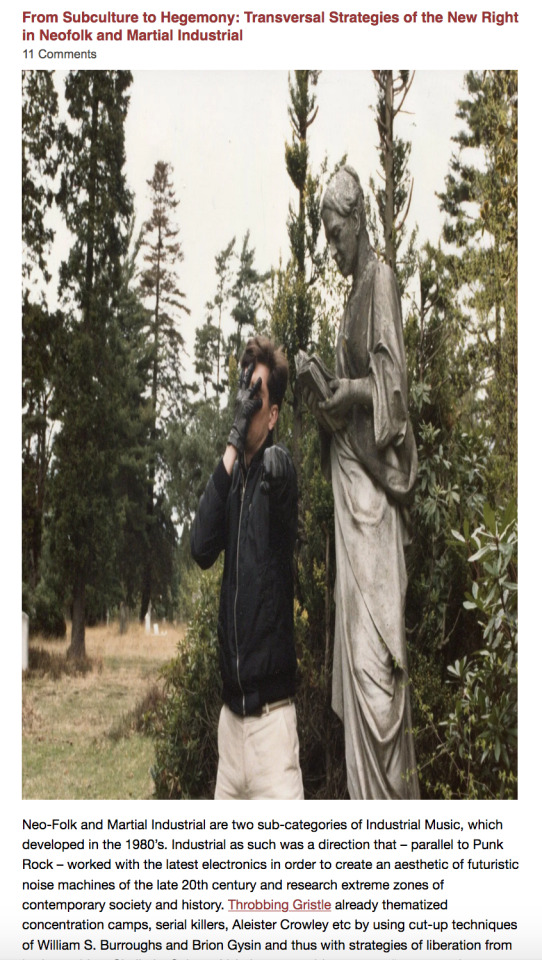
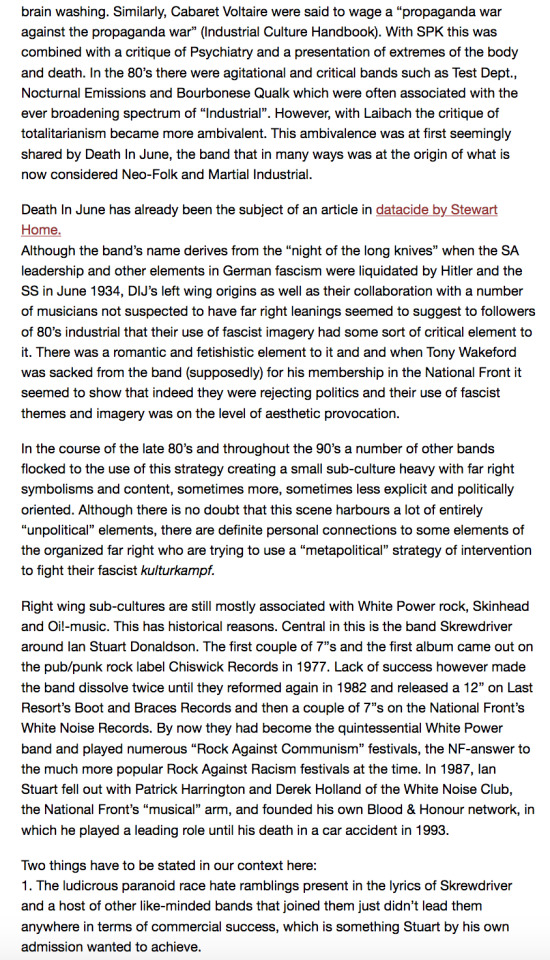
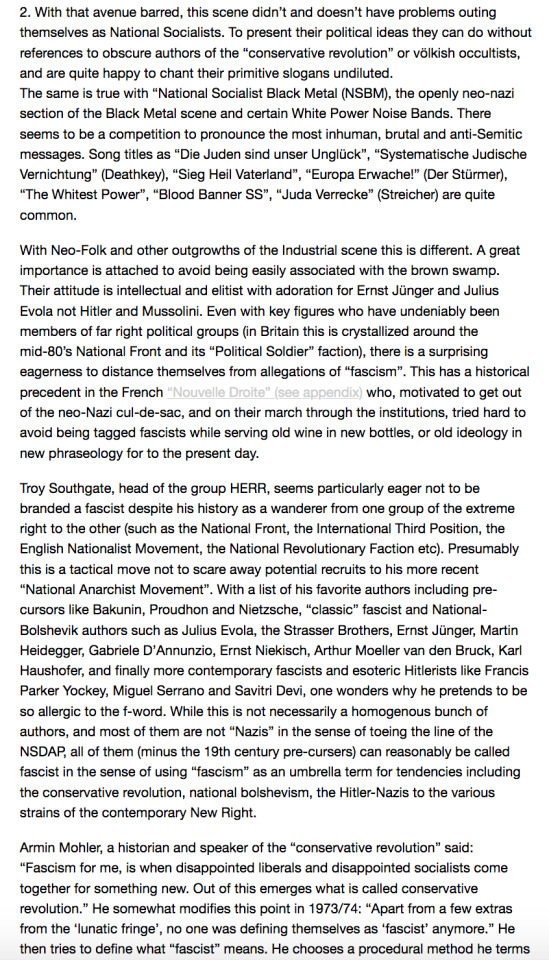
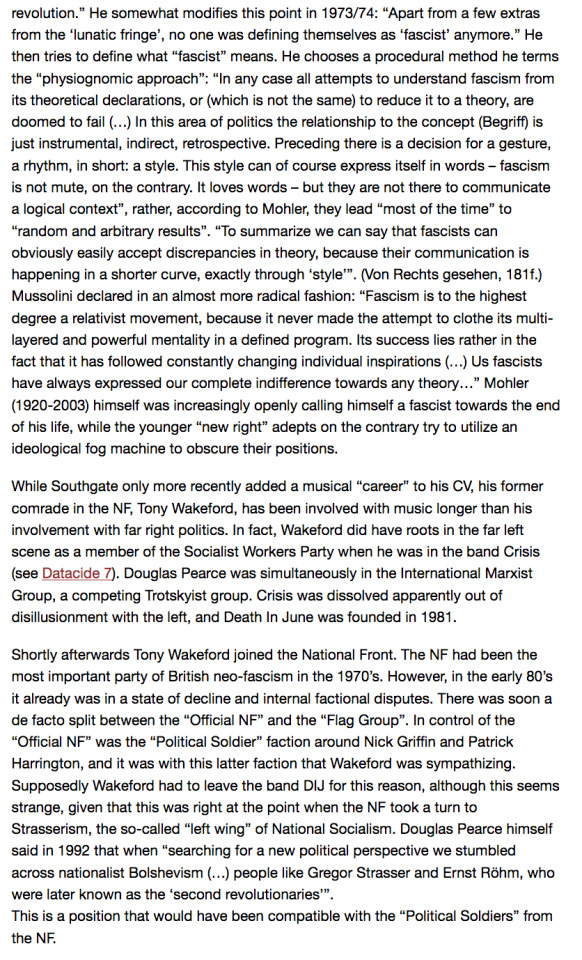

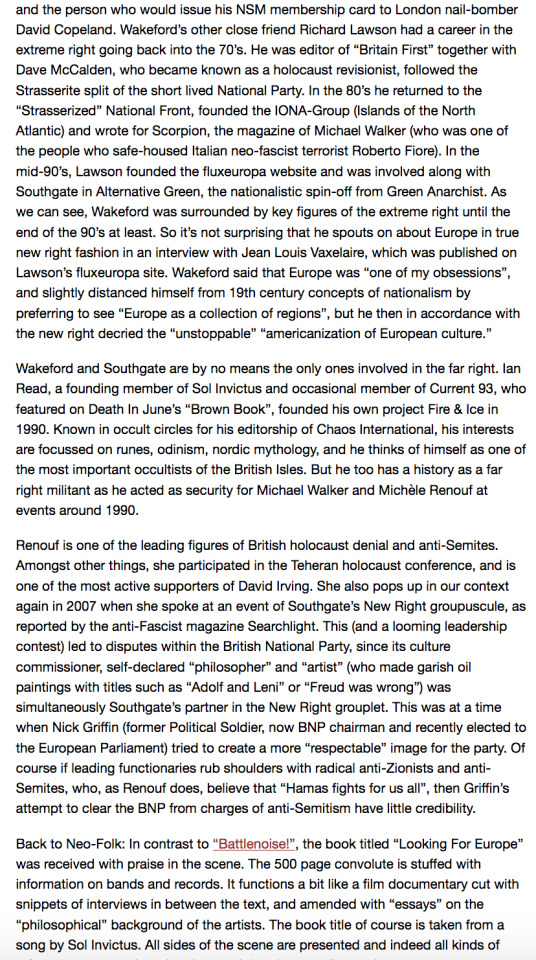
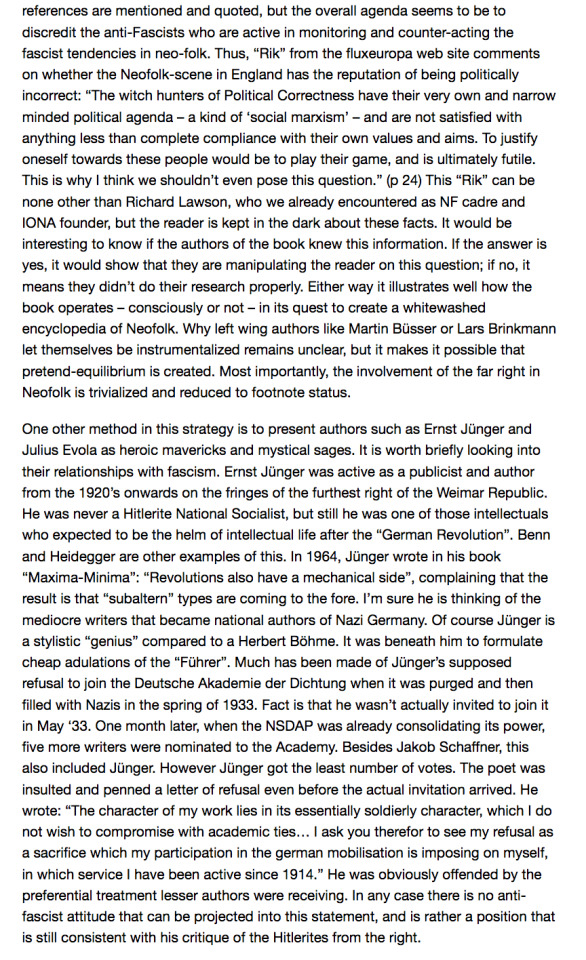
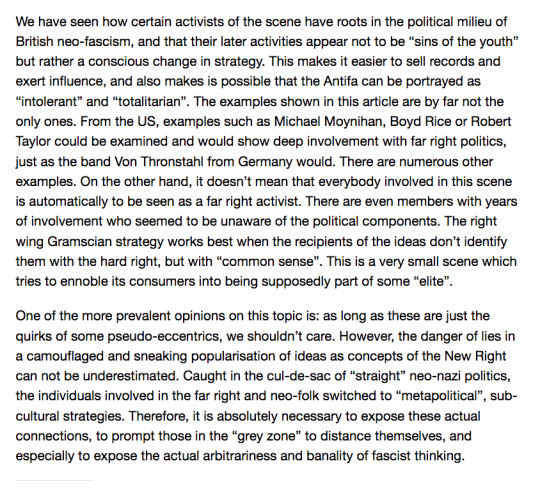

https://datacide-magazine.com/from-subculture-to-hegemony-transversal-strategies-of-the-new-right-in-neofolk-and-martial-industrial/
From Subculture to Hegemony: Transversal Strategies of the New Right in Neofolk and Martial Industrial
11 Comments
Neo-Folk and Martial Industrial are two sub-categories of Industrial Music, which developed in the 1980’s. Industrial as such was a direction that – parallel to Punk Rock – worked with the latest electronics in order to create an aesthetic of futuristic noise machines of the late 20th century and research extreme zones of contemporary society and history. Throbbing Gristle already thematized concentration camps, serial killers, Aleister Crowley etc by using cut-up techniques of William S. Burroughs and Brion Gysin and thus with strategies of liberation from brain washing. Similarly, Cabaret Voltaire were said to wage a “propaganda war against the propaganda war” (Industrial Culture Handbook). With SPK this was combined with a critique of Psychiatry and a presentation of extremes of the body and death. In the 80’s there were agitational and critical bands such as Test Dept., Nocturnal Emissions and Bourbonese Qualk which were often associated with the ever broadening spectrum of “Industrial”. However, with Laibach the critique of totalitarianism became more ambivalent. This ambivalence was at first seemingly shared by Death In June, the band that in many ways was at the origin of what is now considered Neo-Folk and Martial Industrial.
Death In June has already been the subject of an article in datacide by Stewart Home. Although the band’s name derives from the “night of the long knives” when the SA leadership and other elements in German fascism were liquidated by Hitler and the SS in June 1934, DIJ’s left wing origins as well as their collaboration with a number of musicians not suspected to have far right leanings seemed to suggest to followers of 80’s industrial that their use of fascist imagery had some sort of critical element to it. There was a romantic and fetishistic element to it and and when Tony Wakeford was sacked from the band (supposedly) for his membership in the National Front it seemed to show that indeed they were rejecting politics and their use of fascist themes and imagery was on the level of aesthetic provocation.
In the course of the late 80’s and throughout the 90’s a number of other bands flocked to the use of this strategy creating a small sub-culture heavy with far right symbolisms and content, sometimes more, sometimes less explicit and politically oriented. Although there is no doubt that this scene harbours a lot of entirely “unpolitical” elements, there are definite personal connections to some elements of the organized far right who are trying to use a “metapolitical” strategy of intervention to fight their fascist kulturkampf.
Right wing sub-cultures are still mostly associated with White Power rock, Skinhead and Oi!-music. This has historical reasons. Central in this is the band Skrewdriver around Ian Stuart Donaldson. The first couple of 7”s and the first album came out on the pub/punk rock label Chiswick Records in 1977. Lack of success however made the band dissolve twice until they reformed again in 1982 and released a 12” on Last Resort’s Boot and Braces Records and then a couple of 7”s on the National Front’s White Noise Records. By now they had become the quintessential White Power band and played numerous “Rock Against Communism” festivals, the NF-answer to the much more popular Rock Against Racism festivals at the time. In 1987, Ian Stuart fell out with Patrick Harrington and Derek Holland of the White Noise Club, the National Front’s “musical” arm, and founded his own Blood & Honour network, in which he played a leading role until his death in a car accident in 1993.
Two things have to be stated in our context here: 1. The ludicrous paranoid race hate ramblings present in the lyrics of Skrewdriver and a host of other like-minded bands that joined them just didn’t lead them anywhere in terms of commercial success, which is something Stuart by his own admission wanted to achieve. 2. With that avenue barred, this scene didn’t and doesn’t have problems outing themselves as National Socialists. To present their political ideas they can do without references to obscure authors of the “conservative revolution” or völkish occultists, and are quite happy to chant their primitive slogans undiluted. The same is true with “National Socialist Black Metal (NSBM), the openly neo-nazi section of the Black Metal scene and certain White Power Noise Bands. There seems to be a competition to pronounce the most inhuman, brutal and anti-Semitic messages. Song titles as “Die Juden sind unser Unglück”, “Systematische Judische Vernichtung” (Deathkey), “Sieg Heil Vaterland”, “Europa Erwache!” (Der Stürmer), “The Whitest Power”, “Blood Banner SS”, “Juda Verrecke” (Streicher) are quite common.
With Neo-Folk and other outgrowths of the Industrial scene this is different. A great importance is attached to avoid being easily associated with the brown swamp. Their attitude is intellectual and elitist with adoration for Ernst Jünger and Julius Evola not Hitler and Mussolini. Even with key figures who have undeniably been members of far right political groups (in Britain this is crystallized around the mid-80’s National Front and its “Political Soldier” faction), there is a surprising eagerness to distance themselves from allegations of “fascism”. This has a historical precedent in the French “Nouvelle Droite” (see appendix) who, motivated to get out of the neo-Nazi cul-de-sac, and on their march through the institutions, tried hard to avoid being tagged fascists while serving old wine in new bottles, or old ideology in new phraseology for to the present day.
Troy Southgate, head of the group HERR, seems particularly eager not to be branded a fascist despite his history as a wanderer from one group of the extreme right to the other (such as the National Front, the International Third Position, the English Nationalist Movement, the National Revolutionary Faction etc). Presumably this is a tactical move not to scare away potential recruits to his more recent “National Anarchist Movement”. With a list of his favorite authors including pre-cursors like Bakunin, Proudhon and Nietzsche, “classic” fascist and National-Bolshevik authors such as Julius Evola, the Strasser Brothers, Ernst Jünger, Martin Heidegger, Gabriele D’Annunzio, Ernst Niekisch, Arthur Moeller van den Bruck, Karl Haushofer, and finally more contemporary fascists and esoteric Hitlerists like Francis Parker Yockey, Miguel Serrano and Savitri Devi, one wonders why he pretends to be so allergic to the f-word. While this is not necessarily a homogenous bunch of authors, and most of them are not “Nazis” in the sense of toeing the line of the NSDAP, all of them (minus the 19th century pre-cursers) can reasonably be called fascist in the sense of using “fascism” as an umbrella term for tendencies including the conservative revolution, national bolshevism, the Hitler-Nazis to the various strains of the contemporary New Right.
Armin Mohler, a historian and speaker of the “conservative revolution” said: “Fascism for me, is when disappointed liberals and disappointed socialists come together for something new. Out of this emerges what is called conservative revolution.” He somewhat modifies this point in 1973/74: “Apart from a few extras from the ‘lunatic fringe’, no one was defining themselves as ‘fascist’ anymore.” He then tries to define what “fascist” means. He chooses a procedural method he terms the “physiognomic approach”: “In any case all attempts to understand fascism from its theoretical declarations, or (which is not the same) to reduce it to a theory, are doomed to fail (…) In this area of politics the relationship to the concept (Begriff) is just instrumental, indirect, retrospective. Preceding there is a decision for a gesture, a rhythm, in short: a style. This style can of course express itself in words – fascism is not mute, on the contrary. It loves words – but they are not there to communicate a logical context”, rather, according to Mohler, they lead “most of the time” to “random and arbitrary results”. “To summarize we can say that fascists can obviously easily accept discrepancies in theory, because their communication is happening in a shorter curve, exactly through ‘style’”. (Von Rechts gesehen, 181f.) Mussolini declared in an almost more radical fashion: “Fascism is to the highest degree a relativist movement, because it never made the attempt to clothe its multi-layered and powerful mentality in a defined program. Its success lies rather in the fact that it has followed constantly changing individual inspirations (…) Us fascists have always expressed our complete indifference towards any theory…” Mohler (1920-2003) himself was increasingly openly calling himself a fascist towards the end of his life, while the younger “new right” adepts on the contrary try to utilize an ideological fog machine to obscure their positions.
While Southgate only more recently added a musical “career” to his CV, his former comrade in the NF, Tony Wakeford, has been involved with music longer than his involvement with far right politics. In fact, Wakeford did have roots in the far left scene as a member of the Socialist Workers Party when he was in the band Crisis (see Datacide 7). Douglas Pearce was simultaneously in the International Marxist Group, a competing Trotskyist group. Crisis was dissolved apparently out of disillusionment with the left, and Death In June was founded in 1981.
Shortly afterwards Tony Wakeford joined the National Front. The NF had been the most important party of British neo-fascism in the 1970’s. However, in the early 80’s it already was in a state of decline and internal factional disputes. There was soon a de facto split between the “Official NF” and the “Flag Group”. In control of the “Official NF” was the “Political Soldier” faction around Nick Griffin and Patrick Harrington, and it was with this latter faction that Wakeford was sympathizing. Supposedly Wakeford had to leave the band DIJ for this reason, although this seems strange, given that this was right at the point when the NF took a turn to Strasserism, the so-called “left wing” of National Socialism. Douglas Pearce himself said in 1992 that when “searching for a new political perspective we stumbled across nationalist Bolshevism (…) people like Gregor Strasser and Ernst Röhm, who were later known as the ‘second revolutionaries’”. This is a position that would have been compatible with the “Political Soldiers” from the NF.
The question has to be inserted here: why wasn’t DIJ immediately recognized as a far right band by most people? There are different reasons for this. Their background was explicitly left, texts and imagery seemed to be ambivalent, one wanted to recognize not a glorification but also a critique, and when the band was singing the Horst Wessel Lied, it was seen as a provocation embedded in a historical collage. One could and should have been more critical, but songs like “Death of the West” were serving both “left” and “right”-wing anti-Western resentment. People like John Balance and David Tibet, who seemed unsuspicious, were playing on DIJ records and Douglas Pearce was working for a time in Rough Trade record shop, which was supposed to be politically correct – hadn’t they banned Whitehouse records for the fact the band shared the same address as the fascist League of St. George? And last but not least hadn’t Wakeford been sacked from the band for his involvement with the NF?
After leaving DIJ, Wakeford founded the band Above The Ruins with the bassist Gary Smith of No Remorse, which was an openly neo-nazi band similar to Skrewdriver both in terms of musical style and ideological direction. Above The Ruins released one album and became effectively the first line-up of the new band Sol Invictus, in which Wakeford is still active. Sol Invictus first album was called “Against The Modern World” in homage to Julius Evola, on which Smith still played bass, and was joined by Ian Read and Liz Gray. Wakeford has denied this connection for many years, although there was a re-release of the album in 1996 which was also sold through the Sol Invictus mail order. Above the Ruins featured on a National Front benefit sampler called “No Surrender” alongside the likes of Skrewdriver on the Rock-o-Rama label, who have as recently as 2008 released a track by No Remorse on a 30 years anniversary compilation. Interesting detail: The track “Waiting” had not previously been released on Rock-o-Rama, but was on the “Songs of the Wolf” album. This album, released originally on cassette tape in 1984, then on vinyl in 1986, had already reaped praise in Scorpion magazine from Michael Walker, who is another figure of the British New Right as former NF member.
What is certain is that Wakeford makes some sort of effort at damage control concerning his involvements with the far right. His strategy seems to be to make flimsy disclaimers and otherwise deny everything (see his “Message from Tony” on his website). The legend that he was only briefly involved with far right politics in ca. 1984 doesn’t hold up. His involvement with the NF went back at least two years during which he was a member of DIJ. Wakeford has had many personal involvements with important figures of the far right till at least 1999 when Richard Lawson was best man at his wedding, which also include figures like Patrick Harrington and National Socialist Movement leader Tony Williams. We already encountered Patrick Harrington as one of the organizers of the White Noise Club in the mid 80’s, and he was also a part of the Political Soldier faction of the NF. When this faction split at the end of the decade (leaving the small rump of the NF to the “Flag” group), it produced the International Third Position (Griffin, Holland) and the “Third Way” (Harrington), which is posing as a “think tank” rather than a political group. Harrington remains a confidant of Griffin as the chairman of the fake trade union Solidarity, which is essentially a BNP front. Wakeford was good friends with Harrington and Tony Williams, the future leader of the National Socialist Movement and the person who would issue his NSM membership card to London nail-bomber David Copeland. Wakeford’s other close friend Richard Lawson had a career in the extreme right going back into the 70’s. He was editor of “Britain First” together with Dave McCalden, who became known as a holocaust revisionist, followed the Strasserite split of the short lived National Party. In the 80’s he returned to the “Strasserized” National Front, founded the IONA-Group (Islands of the North Atlantic) and wrote for Scorpion, the magazine of Michael Walker (who was one of the people who safe-housed Italian neo-fascist terrorist Roberto Fiore). In the mid-90’s, Lawson founded the fluxeuropa website and was involved along with Southgate in Alternative Green, the nationalistic spin-off from Green Anarchist. As we can see, Wakeford was surrounded by key figures of the extreme right until the end of the 90’s at least. So it’s not surprising that he spouts on about Europe in true new right fashion in an interview with Jean Louis Vaxelaire, which was published on Lawson’s fluxeuropa site. Wakeford said that Europe was “one of my obsessions”, and slightly distanced himself from 19th century concepts of nationalism by preferring to see “Europe as a collection of regions”, but he then in accordance with the new right decried the “unstoppable” “americanization of European culture.”
Wakeford and Southgate are by no means the only ones involved in the far right. Ian Read, a founding member of Sol Invictus and occasional member of Current 93, who featured on Death In June’s “Brown Book”, founded his own project Fire & Ice in 1990. Known in occult circles for his editorship of Chaos International, his interests are focussed on runes, odinism, nordic mythology, and he thinks of himself as one of the most important occultists of the British Isles. But he too has a history as a far right militant as he acted as security for Michael Walker and Michèle Renouf at events around 1990.
Renouf is one of the leading figures of British holocaust denial and anti-Semites. Amongst other things, she participated in the Teheran holocaust conference, and is one of the most active supporters of David Irving. She also pops up in our context again in 2007 when she spoke at an event of Southgate’s New Right groupuscule, as reported by the anti-Fascist magazine Searchlight. This (and a looming leadership contest) led to disputes within the British National Party, since its culture commissioner, self-declared “philosopher” and “artist” (who made garish oil paintings with titles such as “Adolf and Leni” or “Freud was wrong”) was simultaneously Southgate’s partner in the New Right grouplet. This was at a time when Nick Griffin (former Political Soldier, now BNP chairman and recently elected to the European Parliament) tried to create a more “respectable” image for the party. Of course if leading functionaries rub shoulders with radical anti-Zionists and anti-Semites, who, as Renouf does, believe that “Hamas fights for us all”, then Griffin’s attempt to clear the BNP from charges of anti-Semitism have little credibility.
Back to Neo-Folk: In contrast to “Battlenoise!”, the book titled “Looking For Europe” was received with praise in the scene. The 500 page convolute is stuffed with information on bands and records. It functions a bit like a film documentary cut with snippets of interviews in between the text, and amended with “essays” on the “philosophical” background of the artists. The book title of course is taken from a song by Sol Invictus. All sides of the scene are presented and indeed all kinds of references are mentioned and quoted, but the overall agenda seems to be to discredit the anti-Fascists who are active in monitoring and counter-acting the fascist tendencies in neo-folk. Thus, “Rik” from the fluxeuropa web site comments on whether the Neofolk-scene in England has the reputation of being politically incorrect: “The witch hunters of Political Correctness have their very own and narrow minded political agenda – a kind of ‘social marxism’ – and are not satisfied with anything less than complete compliance with their own values and aims. To justify oneself towards these people would be to play their game, and is ultimately futile. This is why I think we shouldn’t even pose this question.” (p 24) This “Rik” can be none other than Richard Lawson, who we already encountered as NF cadre and IONA founder, but the reader is kept in the dark about these facts. It would be interesting to know if the authors of the book knew this information. If the answer is yes, it would show that they are manipulating the reader on this question; if no, it means they didn’t do their research properly. Either way it illustrates well how the book operates – consciously or not – in its quest to create a whitewashed encyclopedia of Neofolk. Why left wing authors like Martin Büsser or Lars Brinkmann let themselves be instrumentalized remains unclear, but it makes it possible that pretend-equilibrium is created. Most importantly, the involvement of the far right in Neofolk is trivialized and reduced to footnote status.
One other method in this strategy is to present authors such as Ernst Jünger and Julius Evola as heroic mavericks and mystical sages. It is worth briefly looking into their relationships with fascism. Ernst Jünger was active as a publicist and author from the 1920’s onwards on the fringes of the furthest right of the Weimar Republic. He was never a Hitlerite National Socialist, but still he was one of those intellectuals who expected to be the helm of intellectual life after the “German Revolution”. Benn and Heidegger are other examples of this. In 1964, Jünger wrote in his book “Maxima-Minima”: “Revolutions also have a mechanical side”, complaining that the result is that “subaltern” types are coming to the fore. I’m sure he is thinking of the mediocre writers that became national authors of Nazi Germany. Of course Jünger is a stylistic “genius” compared to a Herbert Böhme. It was beneath him to formulate cheap adulations of the “Führer”. Much has been made of Jünger’s supposed refusal to join the Deutsche Akademie der Dichtung when it was purged and then filled with Nazis in the spring of 1933. Fact is that he wasn’t actually invited to join it in May ‘33. One month later, when the NSDAP was already consolidating its power, five more writers were nominated to the Academy. Besides Jakob Schaffner, this also included Jünger. However Jünger got the least number of votes. The poet was insulted and penned a letter of refusal even before the actual invitation arrived. He wrote: “The character of my work lies in its essentially soldierly character, which I do not wish to compromise with academic ties… I ask you therefor to see my refusal as a sacrifice which my participation in the german mobilisation is imposing on myself, in which service I have been active since 1914.” He was obviously offended by the preferential treatment lesser authors were receiving. In any case there is no anti-fascist attitude that can be projected into this statement, and is rather a position that is still consistent with his critique of the Hitlerites from the right.
In his post war writings there is clearly a different tone, and Jünger may well have learned something from the horrors, but it is also possible that a very similar message was encrypted in a different way for a different cultural climate (see the box on “Der Waldgang”). Whatever may be the case, there is definitely no self-critical analysis of his own role in the “german mobilization”. Instead, he often revised his older writings including those versions in his collected works making the texts more compatible for the cultural climate of the post war era. In passing it should be mentioned that Armin Mohler, who was Jünger’s secretary for a while in the early 50’s, turned away from the author exactly for this reason.
Julius Evola was one of the main inspirations for the extreme end of Italian post war fascism. Marginally involved with avant-garde art after WWI, he soon became an ideologist of a radical and anti-Semitic “traditionalism”. That he was not just some random occultist will be clear from the following quote from the preface of the English edition of “Men Among the Ruins”: “… for us as integral advocates of the “Imperium”, for us as aristocratically inclined, for us as unbending enemies of plebeian politics, of any ‘nationalistic’ ideology, of any and all party ranks and all forms of party ‘spirit’, as well as of any more or less disguised form of democracy, “Fascism is not enough”. We should have wanted a more radical, more fearless, a more absolute fascism that would exist in pure strength and unbending spirit against any compromise, inflamed by a real fire for imperial power. We can never be viewed as ‘anti-Fascists’ except to the extent that ‘super-Fascism’ can be equated with ‘antifascism’.” Despite this, various protagonists of the neo-folk scene are allowing themselves to present Evola only as an eccentric mystic in order to trivialize what he is really about: “super-fascism”.
Not everybody sees it like that. For example, the Ukrainian academic and fascism scholar Anton Shekhovtsov wrote the article “Apoliteic music: Neo-Folk, Martial Industrial and ‘Metapolitical’ Fascism”, which appeared in “Patterns of Prejudice” magazine in December 2009. His starting point is that in the post war years the radical right had to switch from openly political forms to what he calls “apoliteic” form. Here, he is particularly referring to Evola, Mohler and Jünger. These conservative revolutionaries find themselves in an interregnum until the time would be ripe again for the “glorious” national re-awakening. The metapolitcal fascism of the New Right manifests itself less in the form of parties than in networks of think tanks, conferences, journals, institutes and publishing houses. Shekhovtsov demonstrates how this strategy is at work in Neo-folk and Martial Industrial with bands such as Folkstorm, Death In June, HERR and others. Of course, record labels and distributors, venues and festivals, fashion and fetishism also add to the cohesion of the scene and operate as transmitters of ideas.
We have seen how certain activists of the scene have roots in the political milieu of British neo-fascism, and that their later activities appear not to be “sins of the youth” but rather a conscious change in strategy. This makes it easier to sell records and exert influence, and also makes is possible that the Antifa can be portrayed as “intolerant” and “totalitarian”. The examples shown in this article are by far not the only ones. From the US, examples such as Michael Moynihan, Boyd Rice or Robert Taylor could be examined and would show deep involvement with far right politics, just as the band Von Thronstahl from Germany would. There are numerous other examples. On the other hand, it doesn’t mean that everybody involved in this scene is automatically to be seen as a far right activist. There are even members with years of involvement who seemed to be unaware of the political components. The right wing Gramscian strategy works best when the recipients of the ideas don’t identify them with the hard right, but with “common sense”. This is a very small scene which tries to ennoble its consumers into being supposedly part of some “elite”.
One of the more prevalent opinions on this topic is: as long as these are just the quirks of some pseudo-eccentrics, we shouldn’t care. However, the danger of lies in a camouflaged and sneaking popularisation of ideas as concepts of the New Right can not be underestimated. Caught in the cul-de-sac of “straight” neo-nazi politics, the individuals involved in the far right and neo-folk switched to “metapolitical”, sub-cultural strategies. Therefore, it is absolutely necessary to expose these actual connections, to prompt those in the “grey zone” to distance themselves, and especially to expose the actual arbitrariness and banality of fascist thinking.
8 notes
·
View notes
